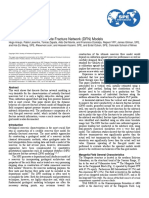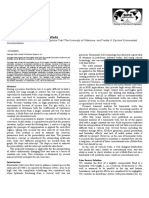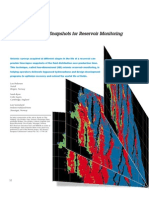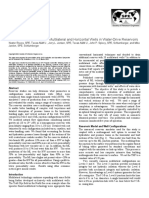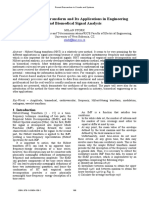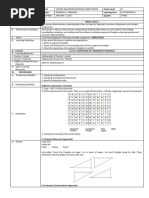Cinco Ley - PVP - YNF PDF
Cinco Ley - PVP - YNF PDF
Uploaded by
Miguel Angel Vidal ArangoCopyright:
Available Formats
Cinco Ley - PVP - YNF PDF
Cinco Ley - PVP - YNF PDF
Uploaded by
Miguel Angel Vidal ArangoOriginal Title
Copyright
Available Formats
Share this document
Did you find this document useful?
Is this content inappropriate?
Copyright:
Available Formats
Cinco Ley - PVP - YNF PDF
Cinco Ley - PVP - YNF PDF
Uploaded by
Miguel Angel Vidal ArangoCopyright:
Available Formats
T
Distinguished
Author Series
Well-Test Analysis for Naturally
Fractured Reservoirs
Heber Cinco-Ley. CSIPSA and UNAM
Summary tion is caused by the simultaneous expansion of both elements, and
Well testing provides a powerful tool to detect and to evaluate hetero- fluid transfer between them, if any, occurs instantaneously without re-
geneities in naturally fractured reservoirs (NFR's). Experience has sistance. This behavior is exhibited by either aheavily fractured reser-
shown that this type of reservoir may display behavior that consists voir with small matrix blocks (Fig. 2a) or by an NFR where fluids are
of a variety of flow models. This paper presents a discussion of the contained mainly in the fracture system (Fig. 2b). The presence of
applications and limitations of pressure-transient tests in the evalua- fractures can be detected by the analysis of well logs and cores.
tion of NFR's. In general, well-test-analysis methods have been developed forho-
mogeneous reservoirs. The pressure behavior in these systems is con-
trolled by the formation flow capacity, kh; porosity ¢' fluid viscosity
Introduction
Ji, and total compressibility, Ct. An essential part of well-test-analysis
Optimizing the exploitation of a reservoir requires a complete de- methods is a flow-regime diagnosis achieved through the application
scription of the formation. A combination of information from vari- of a log-log graph of both pressure and pressure derivative. I3 This
ous sources allows a reliable characterization of the system so that process allows the detection of flow geometries and the presence of
data from seismology, geology, well logging, well tests, core and heterogeneities in the reservoir. The parameters of the system areesti-
fluid analysis, and well flow rates can be used to estimate reservoir ge- mated by use of the specialized graphs of pressure, p, vs. time. t (e.g.,
ometry, oil and gas in place, and flow characteristics of the porous me- p vs.log t,p vs. t'1"pvs. t'l.,p vs. t_'h,p vs. lit, andp vs. :t, correspond-
dium among other factors. Well testing I-I 0 provides an ideal tool to ing to radial,14 linear,15 bilinear,16 spherical,17 constant pressure
find reservoir-flow parameters and to detect and evaluate heteroge- boundary, 18 and pseudosteady-state 2 flows, respectively.
neities that affect the flow process in the formation. Fig. 3 illustrates the behavior of a single-well test (drawdown or
NFR's contain a considerable amount of the world hydrocarbon re- buildup) forradial flow in homogeneous systems. The first part of the
serves. As Fig. 1 shows, the rock in these types of systems may include pressure-derivative graph (unit-slope straight line) shows the pres-
several elements (i.e., vugs, fractures, and matrix). Hydrocarbons are ence of well bore-storage effects followed (after a transition zone) by
contained in both fractures and rock matrix; usually, fractures act as chan- a horizontal portion representing a radial-flow behavior. The kh of the
nels to yield high well-flow rates. Reservoir studies must consider these formation and the skin factor can be determined from the straight line
heterogeneities because they can affect oil and gas recovery significantly. on the semi log graph. The estimated kh for an NFR represents an
Because of the importance ofNFR's, many publications have appeared equivalent value for the fracture/matrix system. As a complement to
that provide an understanding of the behavior of these types of reser- single-well tests, interference tests are used toestimate the storativity
voirs.11.I2 Currently, advances in well-test analysis allow a more reliable of the formation (¢crh); this value is usually high for NFR's because
characterization of these systems based on new flow models that properly it includes the storativity of both fractures and matrix.
account for heterogeneities offractured reservoirs. Owing to space limita- Sometimes a high-productivity well produces from a reservoir
tions, discussing every publication that contributed to the technology with small hydrocarbon reserves; here, the tluids are contained main-
used is impossible. ly in the fractures and the system behaves as a homogeneous medium.
Experience has shown that NFR's may behave according to a vari- Extended drawdown tests allow the early detection of this case during
the appraisal phase of the reservoir.
ety of reservoir-flow models: (I) homogeneous reservoir, (2) multi-
ple region or composite reservoir, (3) anisotropic medium, (4) single
Multiple Region or Composite Reservoir Model. Some NFR's are
fracture system, and (5) double-porosity medium. Fig. 2 shows the
fractured regionally (Fig. 2c) and can therefore be considered to be
main elements of these models, and Table 1 shows the different sets
composed of two regions: a high- and a low-transmissibility region.
of parameters that have to be found to describe the flow behavior in
In this case, the reservoir behaves as a composite radial system. 19
the reservoir for each case. Next, we discuss the application and li- Wells producing from the fractured region exhibit higher productiv-
mitations of these models in well-test analysis. ity than those in the unfractured region. The system is characterized
by the flow capacity of both regions (kh)1 and (khh.
Homogeneous Reservoir Model. This model considers that reser- A single-well pressure test carried out in a well in the fractured re-
voir properties are constant and do not vary throughout the reservoir. gion is first affected by the properties of this nearby region and then
Fractures and rock matrix act as a single medium so that fluid produc- the pressure behavior is controlled by the unfractured region. Fig. 4
presents the graphs for the interpretation of this case. Here a log-log
Copyright 1996 Society of Petroleum Engineers
graph of the pressure derivative shows, at early time, the typical be-
ThiS paper is SPE 31162. Distinguished Author Series articles are general, descriptive pa- havior for wellbore-storage effects, followed by a horizontal straight-
pers that summarize the state of the art in an area of technology by describing recent devel-
opments for readers who are not speCialists in the topics discussed. Written by individuals
line portion representing a radial tlow controlled by the fractured re-
recognized as experts in the area, these articles proVide key references to more defrnitive gion. Then, after a transition period, the derivative curve exhibits
work and present specific details only to illustrate the technology. Purpose: to inform the another straight-line portion above the first horizontal line. If a high
general readership of recent advances In various areas of petroleum engineering. A soft-
bound anthology, SPE Distinguished Author Senes: Dec. 1981-Dec. 1983.15 available trom
contrast exists between the properties of the two regions, the transi-
the SPE Book Order Dept. tion period can reach a unit-slope straight line. suggesting the pres-
,flY" • January 1996 51
Matrix
• i' '::"
.. . '.. ~
.........•....................
-, ::. .: .~ .:;
_~.-'-)_-+-_~(c~)_-1
Fracture
~~; ~'<
~ • :, • . •
. (;:.! •.. ,.,'>'
.. .'. '........
::" ·~.··~·i,'
~---'...::(d:L,J_==ok--_--'-(=e)_---L.._....!..:.!(fL~
~
"':"', ",' ,".
~
"~
o ~ 0 ~
Vug Matrix Low permeability Well Fractures
matrix
Fig. 1-Naturally fractured rock. Fig. 2-Types of NFR's.
ence of a pseudosteady-state flow; that is, the pressure varies linearly fracture (fault) goes through the aquifcr and water is produced even
with time. This is similarto the pseudostcady-state flow that is exhib- if the well is producing at the crest of the reservoir2 J The flow system
ited by closed reservoirs at long times. is characterized by the fracture conducti vity, kjbf; the fracture half-
The semi log graph shows two straight lines corresponding to the length, xr; the distance between the well and the fracture, dj; and the
pressure data falling on the horizontal portions in the derivative formation flow capacity. kh.
graph. The flow capacity of both the fractured and unfractured re- The fracture can be detected and evaluated by well-test analysis. J 8
gions can be estimated from the slope of these straight lines. The po- According to the derivative Jog-log graph (Fig. 6), a single-well test
rous volume of the fractured region is calculated from the data falling is first affected by well bore-storage effects; then, if the fracture does
in the pseudosteady-state-flow period. not intersect the well bore, there is a radial-flow period (horizontal
straight line); and, after a transition period, the well behaves as if it
Anisotropic Reservoir Model. Some NFR's exhibit parallel fracture were located near a constant pressure boundary ( - I-slope straight
planes (Fig. 2d). The reservoir behaves as an anisotropic reservoir line). Finally, the system reaches a bilinear-now period represented
medium; that is, the equivalent permeability in the direction offrac- by a one-quarter-slope straight line. Ref. 18 provides a set of type
tures is much higher than the permeability in the direction normal to curves to analyze this case.
the fractures. This medium exhibits a maximum permeability, kOla" Fig. 6 presents the specialized graphs of interpretation. Here, the
and aminimum permeability, kOlin (Fig. 5). The importance of charac-
pressure data fOrlhe radial tlow are analyzed by applying the semilog
terization of this type of reservoir cannot be overemphasized when
graph to estimate the formation now capacity kh and the skin factors.
dealing with secondary and enhanced recovery projects.
dr is calculated from the slope of the straight-line portion in the
The pressure-interference test is the ideal tool toevaluate the aniso-
constant pressure boundary graph (p vs. lit). The conductivity of the
tropy parameters,20 including k max and kOlin and the orientation of the
fracture, krhr, is obtained from the slope of the straight-line portion in
principal axis of permeability. Simultaneous interference tests mmt
the bilincar-flow graph (p vs. t'/,).
be run with a minimum of three observation wells. As a recommenda-
tion, these wells must not be aligned in a straight line to ensure the cor-
Double-Porosity Model. This is the classic model for NFR's 22,23;
rect evaluation of the parameters. The pressure responses of the ob-
it considers thatthe formation is composed of two media: fracture net-
servation wells look similar on a log-log graph (Fig.5), but they are
displaced in time. The interpretation of the tests is carried out through work and rock matrix. The fracture network essentially provides the
the application of type-curve analysis for the radial-flow model by reservoir-flow channcls, and the hydrocarbons are contained in both
use of the line-source solution. Parameters of anisotropic reservoirs parts of the system. The models proposed to date in this category con-
cannot be estimated from single-well tests because they only provide sider regularly shaped matrix blocks and assume that fluid transferbe-
values for permeability that correspond to the geometric average tween matrix and fractures occurs through transient orpseudosteady-
permeability, kc, defined as (k Olax k Ol in)'I2. state flow conditions. The matrix blocks are rcpresented by cubes,
parallelepipeds, cylinders, or spheres.
Single-Fracture Model. Sometimes a well is producing near a major The behavior of the double-porosity models is characterized by
fracture so that high flow rates are possible. The main fracture may several dimensionless parameters. A common variable forthese mod-
represent a permeable fault that acts as a channel to drain reservoir re- els is the fracture storativity ratio, w, which represents the fracture ex-
gions located away from the wellborc (Fig. 2e). In somc cases, the pansion capacity defined as
TABLE 1-PARAMETERS AND APPLICATIONS OF FLOW MODELS FOR NFR's
Model Parameters Applications
Homogeneous kh and 5 Highly fractured reservoir or low-permeability
matrix
Multiple region or composite (kh)1 and (kh)2, 5 Regionally fractured reservoir
Anisotropic k max and kOlin Oriented fractures
Single fracture FeD, sl, dl, kl' and 5 Reservoir with dominant fracture or well near
a permeable fault
Double porosity (kh)l, 5, ),' and w Heavily fractured reservoir with intermediate
matrix permeability
52 January 1996 • .JIr l'
-a. I
I
_ Ii
Weltbore Storage
a. / ; .
;~I pi
Radial flow
OJ
/~
0
...J
PI .3
I
I I
Log t Log t Log t Log t
Fig. 3-0erivative and semilog graph for radial flow in homoge- Fig. 4-0erivative and semilog graph for radial flow in a two-re-
neous reservoir. gion reservoir.
the system can be dcscribed by two parameters only: wand).. TheA.
results from a combination of AJD, S"'(lD, and 1]"'(lD as
In undersaturated reservoirs, Eq. I calculates how much oil is being
A. = A jD1]maD/SmaD' . . . . . . . . . . . . . . . . . . . . . . . . . . . . . . . (5)
produced from the fractures expressed as a fraction of the total oil pro-
duced. Typical values of ware between 0.001 and 0.5 The values forA. are between 10 -9 and 10 -4. Ahigh valueofthis pa-
Another parameter is the dimensionless diffusi vity of the matrix n rameter indicates a fast interaction bctween matrix and fractures and
vice versa. This case is referred to as the pseudosteady-state matrix-
1]maD = 1]maT~/1]fh,;a, . . . . . . . . . . . . . . . . . . . . . . . . . . . . . (2) tlow model, or the Warren and Root 22 model.
where 1]ma = matrix hydraulic diffusivity, 1]f = fracture hydraulic dif- Fig. 7 presents typical behavior for a single-well test. Here, the log-
fusivity, Tw = well bore radius, and hma = characteristic length of ma- log graph of the pressure derivative shows the wellbore-storage ef-
trix blocks. This parameter is related to how fast the matrix/fracture fects at early time; and, after a transition period, there is a horizontal
interaction occurs. Typical values of 1]maD are between 10 - 9 and line showing a radial flow dominated by the expansion of the frac-
10- 4 . As the value of this parameter increases, the interaction be- tures. Following this, the rock matrix interacts with the fractures, pro-
twecn matrix and fractures occurs at shorter times. ducing a V-shaped curve; and finally, when the matrix-fracture fluid
A third parameterfor double-porosity reservoirs is the dimension- transfer reaches pseudosteady-state flow conditions, the derivative
less matrix/fracture interaction area defined as follows another horizontal line. The semi log graph shows two paral-
lel straight lines, which represent the fracture-dominated flow period
(3) and the total-system (fracture/matrix) -dominated now period, re-
spectively. The tlow capacity kh of the total system is estimated from
where Vb = rock bulk volume, v'na = matrix volume, and Ajb = ma- the slope of the semilog straight lines, and the skin factor is calculated
trix/fracture areas of interaction per unit of rock volume. Ajb is a key from either the first or the second straight line.
parameter in the imbibition process present in waterflooding or water The shape of the transition between the two parallel semilog
encroachment. The value of AJD is 2, 4, and 6 for slabs, cylinders, and straight lines depends on the magnitude of the restriction of the ma-
cubes, respectively. trix/fracture interaction; that is, if a free matrix/fracture interaction (no
In some NFR's, fractures are partially filled by minerals which re- restriction) exists, the transition may approach a straight line with a
duce the flow interaction between matrix and fractures. This situation slope equal to one-half the slope of the two parallel straight lines. The
can be handled introducing a fracture skin factor expressed as: fracture area perunit of rock volume is estimated from the intersection
of the transition straight line and the last straight line. If the matrix/
SmaD = kmax"/k,,h ma , . . . . . . . . . . . . . . . . . . . . . . . . . . . . . (4)
whereXd = average fracture-damage thickness andkd = average frac-
ture-damage permeability. The effect of SmaD is to delay the interac-
tion between matrix and fractures. For high SIIIGD values (severe re-
striction in the matrixlfracture interaction), the pressure behavior of Wellbore
-a. !?
Storage
OJ
o
...J
1It
Fig. 5-log-log graph for observation pressures in interference Fig. 6-0erivative and specialized graphs for a well near a con-
tests in an anisotropic reservoir. ductive fault.
.J)>>"f • January 1996 53
YJ = hydraulic diffusivity, k/rjJWt
rjJ = porosity
A= matrix/fracture interaction parameter
Wellbore Jl = viscosity
Storage
-0. ;0 w = relative fracture expansion
Cl Subscripts
.3 D = dimensionless
f= fracture
ma= matrix
Log t max = maximum
Log t
min = minimum
t= total
I = Region I
2 = Region 2
Fig. 7-Derivative and semilog graph for radial flow in a double-
porosity reservoir.
References
1. Matthews, C.S. and Russell, D.G.: Pre.\·surc·Buildup and F1oll' Tests in
fracture interaction is restricted, the transition zone approaches a sta-
Wells, Monograph Series, SPE, Richardson, TX (1967) 1.
bilized value that can be used to calculate A. 2. Earlougher. R.C. Jr.: Advances in Well Test Analysis, Monograph Series.
The parameters of the double-porosity model may also be esti- SPE. Richardson. TX (1977) 5.
mated through the application of type curves. 3. Ramey, H.1. Jr.. Kumar. A .. and Gulati, M.S.: Gas Well Test Analysis Under
Water·Drive Conditions. American Gas Assn., Arlington. VA (1975).
Comments 4. Theory and Practice of tlze Testin!! of Gas Wells. Energy Resources Con-
The previous discussion covers the basic models used in the analysis servation Board, Calgary (1975).
5. Lee, 1.: "Well Testing," Textbook Series, SPE. Richardson, TX (1982).
of pressure transient tests in NFR's. In practice, combining these
6. Streltsova, T.D.: Well Testin!! in Hetero!!eneous Form<llions. John Wiley
models is sometimes necessary for reliable interpretation of the data; & Sons, New York City (1988).
therefore, the double-porosity model may be combined with the other 7. Stanislav, J.P. and Kabic C.S.: Pressure Transient Analysis, Prentiee-
models that have been presented and discussed. Hall Inc., Englewood Cliffs. NJ (1990).
Another aspect that deserves special attention is related to the de- 8. Sabet. M.A.: Well Test Analysis, Gulf Publishing Co .. Houston (1991).
sign and the conducting of the tests. Use of high-resolution pressure 9. Gringarten. A.C.: 'Type Curve Analysis: What It Can and Cannot Do,"
gauges is desirable to detect small pressure changes observed in many JPT(Jan. 1987) II.
cases, and use of bottomhole shut-in tools is desirable to eliminate 10. Ehlig-Economides, c.: "Usc of the Pressure Derivative for Diagnosing
wellbore-storage effects that can mask valuable information related Pressure-Transient Behavior," JPT (Oct. 1988) 1280.
to heterogeneities in fractured reservoirs. II. Aguilera, R.: Naturally Fractured Reservoirs, Petroleum Publishing Co ..
Tulsa, OK (1980).
12. van Golf-Raeht. T.D.: Fundamentals of FraCllIred Reservoir Engineer-
Conclusions
ing, Elsevier Scientific Publishing Co., Amsterdam (1982).
I. The behavior of NFR's can be studied through the application 13. Bourdet. D. et al.: "A New Set of Type Curves Simplifies Well Test Anal-
of a variety of models that must be considered in simulation studies. ysis," World Oil (May 1983).
2. Pressure transient testing provides a reliable tool to detect and to 14. Horner, D.R.: "Pressure Build Up in Wells." Proc., Third World Pet.
evaluate reservoir heterogeneities that affect the flow process and hy- Cong., The Hague, The Netherlands (1951) Sec. II. 503.
drocarbon recovery in NFR's. 15. Millheim. K.K. and Cichowicz. L.: "Testing and Analyzing Low-Perme-
3. The application of the pressure-derivative curve is essential in ability Fractured Gas Wells," JPT (Feb. 1968) 193; Trans., AIME. 243.
the analysis of pressure tests to determine the proper flow model for 16. Cinco-Ley, H. and Samaniego-V., F: "Transient Pressure Analysis for
Fractured Wells." JPT(Sept. 1981) 1749.
the reservoir.
17. Raghavan. R. and Clark. K.K.: "Vertical Permeability From Limited
4. Single- and multiple-well tests are complementary fordetermin- Entry Flow Tests in Thick formations," SPEJ (Feb. 1975) 65; TrailS.,
ing flow characteristics of reservoirs. AIME,259.
5. Information obtained from a well test must be combined with 18. Abbaszadeh. M.D. and Cinco-Ley, H.: "Pressure Transient Behavior in
data from other sources to understand the production mechanisms a Reservoir With a Finite-Conductivity Fault." SPEFE (March 1995) 26.
present in the reservoirs. 19. van Poolden, H.K. and Bixel, H.C.: "Pressure Drawdown and Buildup in
the Presence of Radial Discontinuities," SPEJ (Sept 1967) 30 I; TrailS ..
Acknowledgments AIME,240.
20. Ramey. H.1. Jr.: "Interference Analysis for Anisotropic Fnrrnations-A
This paper is dedicated to Henry 1. Ramey, who must be considered
Case History." JPT (Oct. 1975) 1290; Trans .. AIME. 259.
the "father of modern well-test analysis" for his valuable and funda- 21. Trocchio, 1.1.: "Investigation of fateh Mishrif Fluid Conductive Faults."
mental contributions in this area. JPT (Aug. 1990) 1038; Trans., AI ME. 289.
22. Warren. J .E. and Root, P.1.: "The Behavior of Naturally Fractured Reser-
Nomenclature voirs," SPEJ (Sept. 1963) 245; TrailS., AIME, 228.
B = Oil FYF, L 3/L3 23. de Swaan-O., A.: "Analytical Solutions for Determining Naturally Frac-
b= width, L tured Reservoir Properties by Well Testing," SPEJ (June 1976) 117;
Trans., AIME, 261.
Ct = total system compressibility, Lt2/m
(~= distance to fault, L
f~D = dimensionless fracture conductivity = kfbflk:g Heber Cinco-Ley is a professor at U. Natl. de Mexico (UNAM). His
h = height, L research interests include reservoir engineering and reservoir simula-
k = permeability, L 2 tion, well-test analysis, and geothermal reservoir engineering. He pre-
m= slope viously was a research engineer at Ins!. Mexicano del Petr61eo and an
instructor at Stanford U. Cinco-Ley was a 1993-94 Section Program
p = pressure. m/Lt2
Chairman, was on the Editorial Review Committee from 1987--89, and
q = flow rate, L3/t was a member of several SPE Annual Meeting technical program com-
s = skin factor. dimensionless mittees. He holds BS and MS degrees from UNAM and a PhD degree
(= time, t from Stanford U., all in petroleum engineering. Photograph for Cinco-
Xj= fracture half-length, L Ley is unavailable.
54 January 1996 • .fly!'
You might also like
- Nissan Check Engine Light Codes & ECU ResetDocument29 pagesNissan Check Engine Light Codes & ECU ResetMu Netsi0% (2)
- Exercises For QUIZ 2Document3 pagesExercises For QUIZ 2louise carino50% (2)
- Expert Schematic DiagramsIIDocument80 pagesExpert Schematic DiagramsIIMauro AzzaliniNo ratings yet
- Well-Test Analysis For Naturally Fractured Reservoirs: SeriesDocument4 pagesWell-Test Analysis For Naturally Fractured Reservoirs: SeriesIván VelázquezNo ratings yet
- Spe 18172 MsDocument16 pagesSpe 18172 MsColin JordanNo ratings yet
- Spe 107013 MSDocument11 pagesSpe 107013 MSOscarNo ratings yet
- 1 s2.0 0920410592900372 MainDocument2 pages1 s2.0 0920410592900372 MainCrysart SlayedNo ratings yet
- SPE 25423 Transient Wellbore Pressure and Flow Rates in A Commingled System With Different Layer PressuresDocument10 pagesSPE 25423 Transient Wellbore Pressure and Flow Rates in A Commingled System With Different Layer Pressuresbladimir2010No ratings yet
- Decline Curve Analysis For Naturally Fractured Reservoirswith Transient Interporosity FlowDocument10 pagesDecline Curve Analysis For Naturally Fractured Reservoirswith Transient Interporosity FlowJuanNo ratings yet
- Decline Curve Analysis Using Type CurvesDocument15 pagesDecline Curve Analysis Using Type Curvesdorian.axel.ptNo ratings yet
- Abbas Zadeh 1993Document20 pagesAbbas Zadeh 1993husseinhshNo ratings yet
- 11025Document19 pages11025mnoriegalNo ratings yet
- SPE 81043 Exact Solution of Two Layer Reservoir With Crossflow Under Constant Pressure ConditionDocument6 pagesSPE 81043 Exact Solution of Two Layer Reservoir With Crossflow Under Constant Pressure ConditionWaleed Barakat MariaNo ratings yet
- SPE 71517 Decline Curve Analysis Using Type Curves - Evaluation of Well Performance Behavior in A Multiwell Reservoir SystemDocument15 pagesSPE 71517 Decline Curve Analysis Using Type Curves - Evaluation of Well Performance Behavior in A Multiwell Reservoir SystemGHIFFARI PARAMANTA ELBEESNo ratings yet
- Massonnat1991 FaciesDocument10 pagesMassonnat1991 FaciesKarolina Bala GadiNo ratings yet
- Porosidad de La Fractura de PbuDocument14 pagesPorosidad de La Fractura de PbuAnonymous 9lckaf9st6No ratings yet
- Celis 1994Document10 pagesCelis 1994sebdiazgonNo ratings yet
- Bourdet 1985Document12 pagesBourdet 1985husseinhshNo ratings yet
- 00035163 Engler + Tiab - Naturally Fractured Reservoir-HighlighterDocument12 pages00035163 Engler + Tiab - Naturally Fractured Reservoir-Highlighterhayaalwateed1233No ratings yet
- SPE 91940 Dynamic Behavior of Discrete Fracture Network (DFN) ModelsDocument8 pagesSPE 91940 Dynamic Behavior of Discrete Fracture Network (DFN) Modelscarloszapata1No ratings yet
- Modeling Aspects of Wellbore Stability IDocument8 pagesModeling Aspects of Wellbore Stability IAhmed GharbiNo ratings yet
- Effects of Reservoir Heterogeneity On Performance: S F IETYDocument11 pagesEffects of Reservoir Heterogeneity On Performance: S F IETYmartin ferrerNo ratings yet
- Spe 90231 PaDocument13 pagesSpe 90231 PaQi ZhangNo ratings yet
- Decline-Curve Analysis of Fractured Reservoirs Wit PDFDocument15 pagesDecline-Curve Analysis of Fractured Reservoirs Wit PDFEmmanuelNo ratings yet
- Spe 125043 Pa PDFDocument14 pagesSpe 125043 Pa PDFFABIANNo ratings yet
- SPE 100384 Diagnosis of Reservoir Behavior From Measured Pressure/Rate DataDocument13 pagesSPE 100384 Diagnosis of Reservoir Behavior From Measured Pressure/Rate DataHernández ChanNo ratings yet
- Estimacion de K y SDocument9 pagesEstimacion de K y SRurik VeRaNo ratings yet
- PTA Hor WellDocument8 pagesPTA Hor WellsayidNo ratings yet
- Kim 1980Document7 pagesKim 1980Pablo MuñozNo ratings yet
- Paper Saturation Height MethodsDocument12 pagesPaper Saturation Height Methodsscribdhuli100% (1)
- Knut-Andreas Lie and Bradley T. MallisonDocument9 pagesKnut-Andreas Lie and Bradley T. MallisonSeptianjefryCNNo ratings yet
- 1989 ChenDocument38 pages1989 ChensddNo ratings yet
- The Practical Aspects of Interlayer CrossflowDocument6 pagesThe Practical Aspects of Interlayer CrossflowNadirNo ratings yet
- 10 HB5 Sam@6014-Pa PDFDocument12 pages10 HB5 Sam@6014-Pa PDFJORGE ADAN LUNA CARRIZOSANo ratings yet
- Water Floods PopulationDocument13 pagesWater Floods PopulationEd JuarezNo ratings yet
- Spe 146580 MS PDocument17 pagesSpe 146580 MS Pdownloader1983No ratings yet
- Saldanac 1986Document15 pagesSaldanac 1986vastaguenNo ratings yet
- Effects of Pore Geometry ON Log-Derived Cementation Exponents in Carbonate Reservoirs Paul0Document13 pagesEffects of Pore Geometry ON Log-Derived Cementation Exponents in Carbonate Reservoirs Paul0Andriani RiniNo ratings yet
- SPE 77951 Multirate Test in Horizontal Wells: SurcolombianaDocument12 pagesSPE 77951 Multirate Test in Horizontal Wells: SurcolombianaJorge RochaNo ratings yet
- Upscaling of Flow Units For Reservoir Flow Incorporating Small-Scale HeterogeneitiesDocument19 pagesUpscaling of Flow Units For Reservoir Flow Incorporating Small-Scale HeterogeneitiessifatNo ratings yet
- SPE 114591 Rate Transient Analysis in Naturally Fractured Shale Gas ReservoirsDocument17 pagesSPE 114591 Rate Transient Analysis in Naturally Fractured Shale Gas ReservoirsIbrahim ElsawyNo ratings yet
- Warren, J. E. and Root, P. J. The Behavior of Naturally Fractured ReservoirsDocument11 pagesWarren, J. E. and Root, P. J. The Behavior of Naturally Fractured ReservoirsSolenti D'nouNo ratings yet
- Flow Units VerificationDocument6 pagesFlow Units Verificationamateur_no1No ratings yet
- Rec Erc 74 01Document42 pagesRec Erc 74 01MehriNo ratings yet
- Parsons (1966) - Permeability of Idealized Fracture RockDocument11 pagesParsons (1966) - Permeability of Idealized Fracture RockJorge Luis Pirela GarciaNo ratings yet
- 1 LinkingStaticandDynamicDataforDistributedPermeabilityEstimationalongHorizontalOpenHoleDrainsinaCarbonateReservoirDocument13 pages1 LinkingStaticandDynamicDataforDistributedPermeabilityEstimationalongHorizontalOpenHoleDrainsinaCarbonateReservoirCristian MendozaNo ratings yet
- 2006 AIChEJ ARK Flow RegimesDocument19 pages2006 AIChEJ ARK Flow RegimesGopal KasatNo ratings yet
- Seismic Snapshots For Reservoir MonitoringDocument12 pagesSeismic Snapshots For Reservoir MonitoringPrasanti Plaban Dash100% (1)
- Sharma 2002Document8 pagesSharma 2002thien.le1811No ratings yet
- SPE 62917 Advances in Multilayer Reservoir Testing and Analysis Using Numerical Well Testing and Reservoir SimulationDocument14 pagesSPE 62917 Advances in Multilayer Reservoir Testing and Analysis Using Numerical Well Testing and Reservoir SimulationhusseinhshNo ratings yet
- SPE 94623 Dynamics of Fluid Substitution While Drilling and Completing Long Horizontal-Section WellsDocument8 pagesSPE 94623 Dynamics of Fluid Substitution While Drilling and Completing Long Horizontal-Section WellsCatharina JenifferNo ratings yet
- SPE-169004-MS Understanding Shale Performance: Performance Analysis Workflow With Analytical Models in Eagle Ford Shale PlayDocument15 pagesSPE-169004-MS Understanding Shale Performance: Performance Analysis Workflow With Analytical Models in Eagle Ford Shale Playtomk2220No ratings yet
- Bilinear Flow Horizontal 1995Document8 pagesBilinear Flow Horizontal 1995sajjad moradiNo ratings yet
- Msiptc PDFDocument28 pagesMsiptc PDFAiwarikiaarNo ratings yet
- Valavanides Etal JPSE 147 2016Document21 pagesValavanides Etal JPSE 147 2016mvalavanidesNo ratings yet
- Spe 62854 MSDocument14 pagesSpe 62854 MSSabeur SassiNo ratings yet
- Analytical and Numerical Modeling of Flow in A Fractured Gneiss AquiferDocument6 pagesAnalytical and Numerical Modeling of Flow in A Fractured Gneiss AquiferRamadan AbdelazizNo ratings yet
- (Full Permission)Document12 pages(Full Permission)mohamadi42No ratings yet
- SPE 122594 Well Test Analysis in Naturally Fractured Gas Condensate Reservoirs Below Dew Point PressureDocument16 pagesSPE 122594 Well Test Analysis in Naturally Fractured Gas Condensate Reservoirs Below Dew Point PressureGabriel EduardoNo ratings yet
- Modelling of Secondary Petroleum Migration Using Invasion Percolation TechniquesDocument17 pagesModelling of Secondary Petroleum Migration Using Invasion Percolation TechniquesYash GuptaNo ratings yet
- Enhanced Reservoir Description Using Cor PDFDocument16 pagesEnhanced Reservoir Description Using Cor PDFLibya TripoliNo ratings yet
- Spe-27907-MsDocument9 pagesSpe-27907-Msleonelz6aNo ratings yet
- Economic Comparisons of Multilateral and Horizontal Wells in Water-Drive Reservoirs-Rivera2003-SPE80927Document7 pagesEconomic Comparisons of Multilateral and Horizontal Wells in Water-Drive Reservoirs-Rivera2003-SPE80927Miguel Angel Vidal ArangoNo ratings yet
- Optimization of Multiple Hydraulically F PDFDocument17 pagesOptimization of Multiple Hydraulically F PDFMiguel Angel Vidal ArangoNo ratings yet
- Profile Visualization: Geoscience ANALYST Tip - September 2018Document4 pagesProfile Visualization: Geoscience ANALYST Tip - September 2018Miguel Angel Vidal ArangoNo ratings yet
- Demo 01 Multi RegDocument118 pagesDemo 01 Multi RegMiguel Angel Vidal ArangoNo ratings yet
- Reservoir Geomechanics Course AnnouncementDocument2 pagesReservoir Geomechanics Course AnnouncementMiguel Angel Vidal ArangoNo ratings yet
- Technical Translation in Nuclear Energy: New Terms, Context, EquivalenceDocument4 pagesTechnical Translation in Nuclear Energy: New Terms, Context, EquivalenceMiguel Angel Vidal ArangoNo ratings yet
- Reservoir Organic Geochemistry: Processes and ApplicationsDocument3 pagesReservoir Organic Geochemistry: Processes and ApplicationsMiguel Angel Vidal Arango100% (1)
- RTA (Rate Transient Analysis) Fact SheetDocument2 pagesRTA (Rate Transient Analysis) Fact SheetMiguel Angel Vidal ArangoNo ratings yet
- Module 1Document6 pagesModule 1N BHUSHANNo ratings yet
- The Missing Link: The Testbench To Dut Connection: David Rich - Mentor A Siemens BusinessDocument10 pagesThe Missing Link: The Testbench To Dut Connection: David Rich - Mentor A Siemens BusinessMarko NedicNo ratings yet
- Earthquake Prediction Using Machine Learning Algorithm: ISSN: 2277-3878 (Online), Volume-8 Issue-6, March 2020Document5 pagesEarthquake Prediction Using Machine Learning Algorithm: ISSN: 2277-3878 (Online), Volume-8 Issue-6, March 2020kunamsettypavankiransaiNo ratings yet
- Electrolux W645H-W4300H, W4180N - S, W4130N - S, W4250N - S 233165 PDFDocument140 pagesElectrolux W645H-W4300H, W4180N - S, W4130N - S, W4250N - S 233165 PDFYoyok Sudibyo0% (1)
- Application Note 30: MIC2179 Lithium-Ion Battery Charger by Jeff DixonDocument8 pagesApplication Note 30: MIC2179 Lithium-Ion Battery Charger by Jeff DixonIyon ManakarraNo ratings yet
- Hilbert-Huang Transform and Its Applications in Engineering and Biomedical Signal AnalysisDocument8 pagesHilbert-Huang Transform and Its Applications in Engineering and Biomedical Signal AnalysisNithyaa SathishNo ratings yet
- Complete Layout of RC 120 Roller Chain Drive: Top ViewDocument1 pageComplete Layout of RC 120 Roller Chain Drive: Top ViewJames VincentNo ratings yet
- Chapter-1 Part-1 Wind Load Lecture NoteDocument45 pagesChapter-1 Part-1 Wind Load Lecture NoteWendimu TolessaNo ratings yet
- 22 Witnesses Observe A Ufo Larger Than A StadiumDocument6 pages22 Witnesses Observe A Ufo Larger Than A Stadiumalan galvez malpartidaNo ratings yet
- Graphtheorysiri 180406131723Document52 pagesGraphtheorysiri 180406131723Garima GaurNo ratings yet
- Rodolfo-How To Create Cell File in Google EarthDocument20 pagesRodolfo-How To Create Cell File in Google EarthJade CarloNo ratings yet
- Ircuit Reaker Presented byDocument20 pagesIrcuit Reaker Presented byaamir sohail100% (9)
- G135 - Guidance For Applicaton of P102-24655-2Document6 pagesG135 - Guidance For Applicaton of P102-24655-2walterNo ratings yet
- Analysis Price of Houses in ArubaDocument21 pagesAnalysis Price of Houses in ArubaBryan SaenzNo ratings yet
- DLP_Q3_MELC37_W3_D2ILLUSTRATE TRIANGLE CONGRUENCEDocument3 pagesDLP_Q3_MELC37_W3_D2ILLUSTRATE TRIANGLE CONGRUENCENimrod CarolinoNo ratings yet
- Air Cooler Water Pump GuardDocument4 pagesAir Cooler Water Pump Guardsanjay6969No ratings yet
- Chapter 6 - Bond Valuation and Interest RatesDocument36 pagesChapter 6 - Bond Valuation and Interest RatesAmeer B. BalochNo ratings yet
- FLAT Practice Set - 1Document3 pagesFLAT Practice Set - 1Bala KumarNo ratings yet
- Oracle Financial Interview Questions and Answers: How Many Key Flexfields Are There in Oracle Financials?Document12 pagesOracle Financial Interview Questions and Answers: How Many Key Flexfields Are There in Oracle Financials?AnilkNo ratings yet
- AC MachinesDocument41 pagesAC Machineskr_abhijeet72356587No ratings yet
- Countershaft and PlanetaryDocument16 pagesCountershaft and PlanetaryScribdTranslationsNo ratings yet
- Document PDFDocument173 pagesDocument PDFpolo007mxNo ratings yet
- Rank Booster Test Series: 12 and 13 Students (CHEMISTRY (1) ) Target Iit - Jee - 2016Document11 pagesRank Booster Test Series: 12 and 13 Students (CHEMISTRY (1) ) Target Iit - Jee - 2016ashu mishraNo ratings yet
- Synthesis Gas Production and Derived ChemicalsDocument53 pagesSynthesis Gas Production and Derived Chemicalsmuhammad izzul100% (1)
- Organic Chemistry: OutlineDocument12 pagesOrganic Chemistry: OutlineShaker MahmoodNo ratings yet
- SSH at Password: CD .. Chmod - R 701 CD Mkdir Public - HTML Chmod - R 705 Public - HTMLDocument1 pageSSH at Password: CD .. Chmod - R 701 CD Mkdir Public - HTML Chmod - R 705 Public - HTMLpolar necksonNo ratings yet
- Data Sheet PT8A2513NE Simple Universal Timer: Part Number PackageDocument4 pagesData Sheet PT8A2513NE Simple Universal Timer: Part Number PackageTed SunNo ratings yet



















